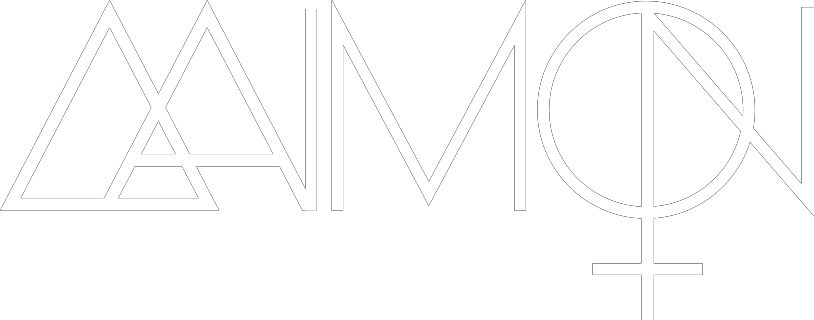About
∆AIMON is the dark electronic music project of Nancy Showers and Brant Showers, accompanied by drummer Mark Barnhart. Atmospheric compositions built upon occult aesthetics, weighed heavily by a bleak and often romantic sentiment.
“Having formed late July of 2010, husband and wife team Brant and Nancy Showers came to the early attention of witch-house fans through their first songs made public on SoundCloud (‘amen’ and a cover of the Swans song, ‘A SCREW’). This attention gained them the release of their first EP, amen, on the Bay Area experimental electronic label Tundra Dubs in February of 2011. Their extensive amount of remix work within the dark electronic community helped maintain a loyal fan base and an active role in the underground electronic scenes. Their follow-up EP, FLATLINER, was released on vinyl through Tundra Dubs in April of 2012 and as an expanded CD edition through the Canadian label, Artoffact Records in November of the same year. Both editions received critical acclaim and are were widely praised in the dark electronic/witch-house scene as well as more contemporary industrial and goth related circles.
With FLATLINER defying genres and bridging the gap between the indie and traditional industrial genres, ∆AIMON continued to grow a larger following, shedding much of their earlier mystique in order to interact directly with fans and peers. This new transparency formed the foundation of their first full length album (self-titled) released December 3rd, 2013 through Artoffact Records. The ∆AIMON album, built-upon live show experiences and an interest in expressing their anxieties and emotions much more directly, once again received an impressive response from media and fans.
∆AIMON has remained active on social networks, retaining a close interaction with fans and the dark electronic community. With the release of their album, ∆AIMON has expressed interest in expanding their live shows as well as developing more art-related concepts.”
For more info, please contact us.
On the name ∆AIMON
We commonly receive questions regarding the pronunciation and various alternate spellings of the name ∆AIMON so we have decided to share a bit of the thought process and circumstances that lead to our selecting this particular project name. (this subject was discussed at length in forums and various interviews, so a great deal of this note has been collected from various sources).
The name we chose was presented to us as an appropriate collection of symbols and purpose in a combined ritualized sigil. There is no correct pronunciation of the name and we’ve purposely obfuscated the assumed phonetic definition through use of various derivatives.
The name itself is a reference to the word daimon or daemon but is purposely left open for interpretation (and indeed we engineered a bit of it through use of aaimon and the EP title ‘amen’) but more on that further down. First it must be clarified that the word daimon in its Greek etymology was understood and denoted as meaning the spiritual sense of “inspiration” as coming from an intervening force. Often recognised as the driving spirit of the human genius (or put differently, a spark of awareness outside of human comprehension delivered to us in moments that seem to reach outside of our natural capabilites), it became a source of divination for philosophers such as Plato specifically who would look to his personal daimon for guidance. It wasn’t until the Greek language edition of the Bible used this same word in reference to maligned spirits that it took on a negative connotation. Not to get into a heavy religious debate, we allow within the interpretation of our name both positive and negative connotations as they hold equal importance.
While I don’t consider myself a Thelemite or much of a fan of Aleister Crowley himself, his (and MacGregors) studies of the Book of Abramelin is spot on in my opinion. This manuscript tells of the Great Work, which essentially amounts to the “Knowledge and Conversation with the Holy Guardian Angel.” It was in a discussion of this Work that Crowley properly made the connection between the original use of the word daimon and the spirit being referred to as the Holy Guardian Angel. Furthermore, to him this spirit represented our highest possible Self transcended and could be called upon to awaken an unknown potential within us. It is still used commonly to this end in occult circles as an initiation of inner purpose or True Self. I see it as fundamental work towards individual wholeness and sincerity invoked through sexuality, pleasure and fear.
The psychological and occult significance of the word and the fact that it was brought to our attention through a small act of synchronism pretty much solidified our use of it. We were also further impressed with the closeness in it’s meaning and visual identity with the name Aimon known in the Goetia as the 7th Prince of hell and a counterpart of the Egyptian god sharing the same name. Both represent the hidden or secret wisdom revealed and are called upon to awaken insight.
Since we had already decided that the name “worked” with more impact as a sigilised image, we decided to work in the fetishistic powers of the open triangle (which represents inner light in Esoteric traditions and which was also in keeping with the Greek delta referenced attribute) as well as the negative and sacrificial aspects of the upside-down cross/of St. Peter, and the sexual and alchemical attributes of Venus. To continue the idea of the visual representation and to give a nod to the Egyptian and Goetic spirit(s), we decided to use the double AA rather than a D in situations where alt-characters aren’t applicable.
There’s more to it that remains hidden, but we can’t share everything…
– Brant Showers
